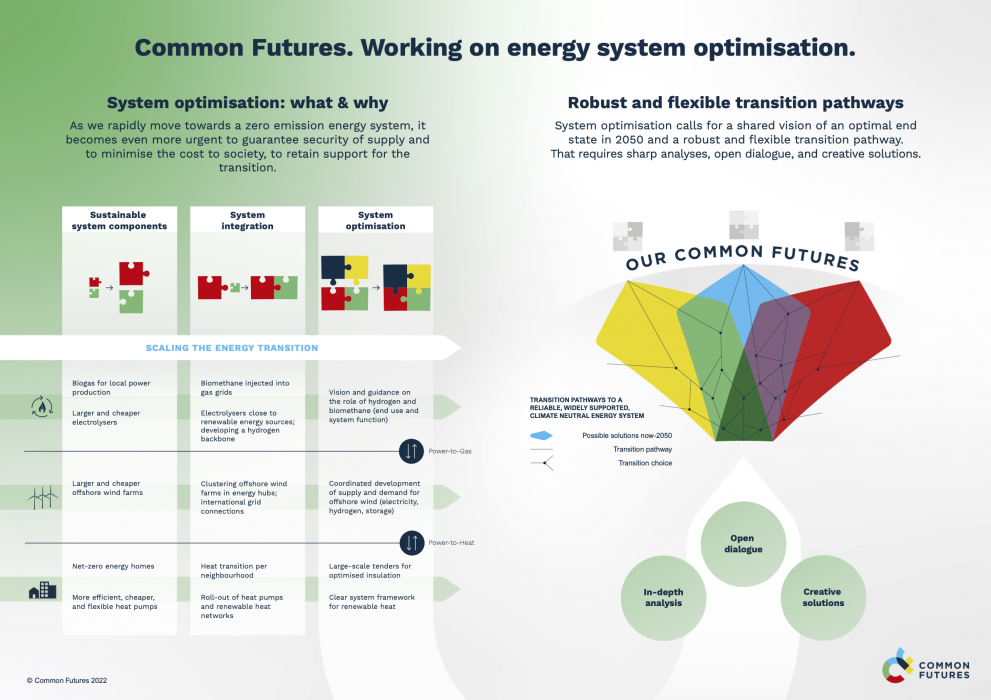
Now we are accelerating the European energy transition towards zero emissions, it becomes increasingly important to guarantee security of supply, minimise societal cost, and retain public support for the transition. For that, we need to connect developments on the supply and demand side, and work on energy system optimisation!
So far, we have been working on developing the necessary components for a sustainable energy system. We have only just begun to connect those developments via system integration. And now we already need to move on to energy system optimisation. I will show what this means in three big areas of the energy transition.
RENEWABLE GASES: PUTTING BIOMETHANE AND GREEN HYDROGEN TO USE
Biomethane and green hydrogen can be a great complement to (renewable) electrification. So far, most biogas installations produce electricity and some heat locally; now we need to move on to purify it to biomethane and use our grids to enable full use of the value it can have for the system, including its storability. At the same time, we are scaling up electrolysers for the production of green hydrogen; the next step is to site them close to large sources of renewable electricity production, to help integrate all that energy into the system.
The final step of energy system optimisation means developing a vision on the optimal role of hydrogen and biomethane in the system, and steering towards that.
INTEGRATING OFFSHORE WIND
There has already been a great development in scaling up offshore wind farms, and making them cheaper, which has made them into workhorses of the energy transition in Europe. Next step is to cluster offshore wind farms in energy hubs, and to connect those internationally. In the system optimisation step, it is all about a coordinated development of supply and demand, for electricity and hydrogen, taking into account the options to store energy for weeks and months.
EMISSION REDUCTION IN BUILDINGS
Valuable components for the energy transition in buildings have been developed, such as insulating glazing, insulation systems for roofs, walls, and floors, and more efficient, affordable and flexible heat pumps. In a system integration step, concepts for whole housing districts are being developed, with a roll-out of heat pumps and renewable district heating. The optimisation step will bring large-scale tenders for optimised insulation and clear frameworks for the development of sustainable heating, taking local, regional, and national system considerations into account.
ALL TOGETHER NOW
For the overall energy system transition, we will need to apply this optimisation to the system as a whole. To take the three examples above: the vision on the optimal role of renewable gases will have an impact on the role that hydrogen plays in integrating offshore wind, and on the role that hybrid heat pumps play in achieving emission reduction in buildings. There is a lot to gain, in terms of societal costs, societal benefits, and in the end, the speed at which we succeed in getting to net-zero emissions!
Recommended links:
About the author:
Kees van der Leun has been an energy transition consultant for over 35 years, after joining the start-up Ecofys in 1986. In recent years, he has focussed on strategies for energy system integration, including work for Gas for Climate, the European Hydrogen Backbone, and North Sea Wind Power Hub. Last September, he founded the new consultancy Common Futures together with Daan Peters. The growing team fully focusses on energy system optimisation.
Disclaimer: This article is a contribution from a partner. All rights reserved.
Neither the European Commission nor any person acting on behalf of the Commission is responsible for the use that might be made of the information in the article. The opinions expressed are those of the author(s) only and should not be considered as representative of the European Commission’s official position.
RELATED ARTICLES:
➔ Engage youth to accelerate the energy transition: 3 ways to go beyond rhetoric
➔ Green hydrogen to de-risk the energy transition
➔ Convergence of geopolitical, energy and climate crisis urges us to act and co-operate
Details
- Publication date
- 24 May 2022
- Author
- European Climate, Infrastructure and Environment Executive Agency
